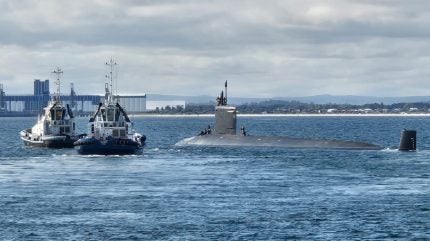
One Virginia-class nuclear-powered fast attack submarine (SSN) will replace another for maintenance according to US Navy updates on 10 September 2024.
USS Hawaii (SSN 776) has departed HMAS Stirling from an historic maintenance period under the auspices of Royal Australian Navy personnel, while USS North Carolina (SSN 777) enters depot modernisation at Pearl Harbour Naval Shipyard.

Discover B2B Marketing That Performs
Combine business intelligence and editorial excellence to reach engaged professionals across 36 leading media platforms.
This rotation ensures a persistent availability of SSNs at sea at a time when US submarine capacity has taken a hit due to a major labour shortage in the naval industrial base.
SSN force structure
The Navy has stated that industry best practice would call for about 20% of the SSN force to be in depot maintenance (and for none to be idle) at any given moment.
However, 33% of the force has been out of service over the last two fiscal years. Moreover, the last time that less than 20% of the SSN force was out of service was in FY2015.
Currently, there are 22 Virginia-class units in active service, whereas the Navy aims to operate 66 boats – an ideal force level put forward in June 2023.

US Tariffs are shifting - will you react or anticipate?
Don’t let policy changes catch you off guard. Stay proactive with real-time data and expert analysis.
By GlobalDataAlthough the service has procured at a rate of two boats per year, the actual production rate has fallen short, and since 2022 has been limited by shipyard and supplier firm workforce and supply chain challenges to about 1.2 to 1.4 boats per year, resulting in a growing backlog of boats procured but not yet built.
Furthermore, this shortage does not even consider US obligations to supply Virginia-class boats to the Royal Australian Navy under the first pillar of the trialteral AUKUS alliance.
Growing reliance on partner nations for maintenance
With demand at an all-time high and capacity at an all-time low, the US Navy is increasingly leaning on partner nations for the upkeep of its platforms, for better of worse.
Handing responsibility to Australian personnel for USS Hawaii, with the support of experienced American SSN operators, at HMAS Stirling, the decision supports Australia’s ability to manage and operate a nuclear-powered submarine capability in the future.
Though, training Australian service people to maintain SSNs predates this milestone. Australian sailors have shadowed US technicians since late 2023. In fact, in December, Australian personnel witnessed maintenance at Pearl Harbour Naval Shipyard.
This “historic” milestone began in mid-August, when the US submarine tender USS Emory S. Land (AS 39) arrived in Western Australia to support RAN maintenance of the SSN.
However, it is noteworthy that Hanwha Ocean was the first ever Korean shipyard to perform maintenance on a US Navy vessel this week, albeit a Lewis and Clark-class auxiliary ship, the Wally Schirra.



